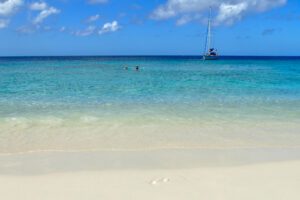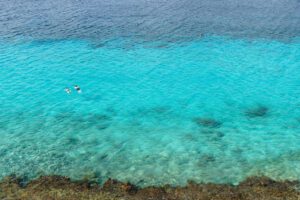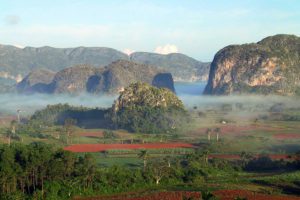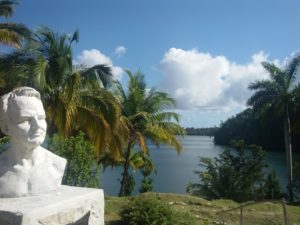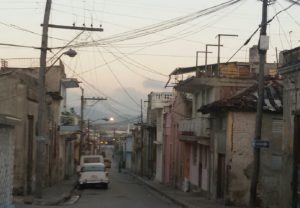As I explained in my post MAGNIFICENT MARTINIQUE: Ten Places Not to Miss on Your Visit – even when exploring by public bus, this French Caribbean Island offers an incredible variety of cultural and natural treasures some of which are indisputably the pristine shores. What many visitors don’t know: Numerous of the most beautiful beaches lining Martinique can be conveniently and very inexpensively visited by public bus.

In this post, you’ll find comprehensive info on which coach to take and how to get there.
Martinique
Although Martinique is an island in the Caribbean, it is a so-called Départements d’Outre-Mer, hence, a French overseas department for historical and political reasons. So are her big sister Goudeloupe and three other territories, by the way. However, this status makes the island politically a full part of France and therefore also of the European Union. Yet, Martinique is almost 7,000 kilometers away from Paris– not only geographically, but also mentally. Albeit, the official language is French, nonetheless, the inhabitants speak Creole, a language that derives from French, Indian, and African tongues.
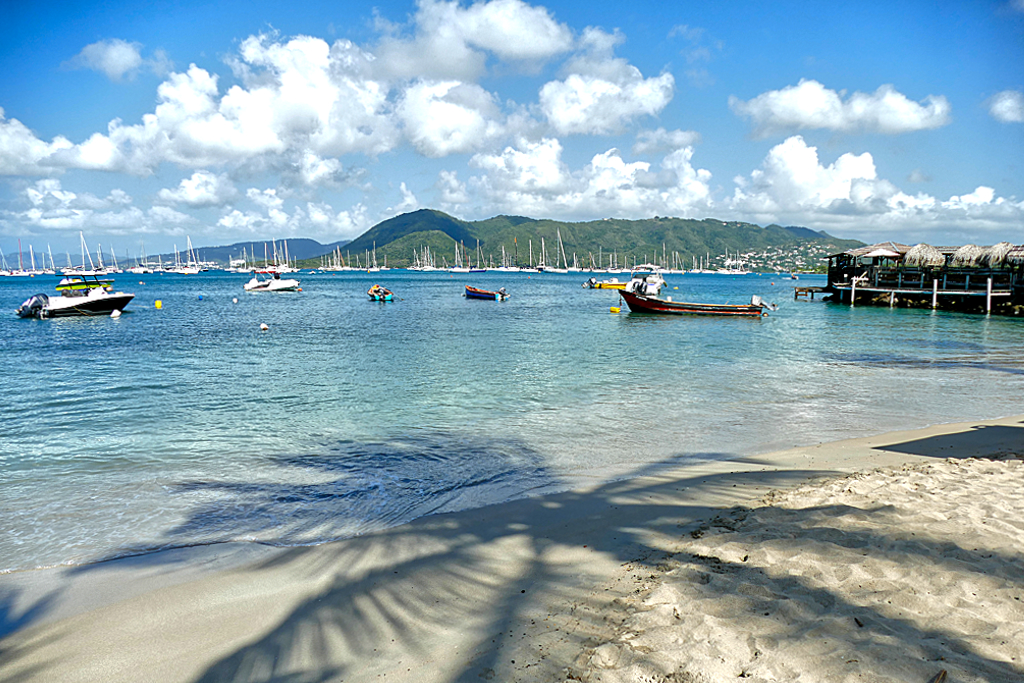
The varied landscape, the wild, lush mountainous terrain in the north, the long white, palm-lined sandy beaches along the turquoise water, and the traditional Creole culture make Martinique a small paradise. Mind you, the aborigines called the island Madinina which translates to Flower Island. They were spot on: When you drive across the island and see the beguiling amount of colorful flowers in full bloom, you’ll immediately understand why.
Yet, Martinique is rightfully famous for its incredible number of beautiful beaches. The island boasts a 350-kilometer-long coastline after all! Especially the southern part is basically hemmed with long stretches of white-golden sand. Palm trees are swaying in the light tropical breezes while the turquoise glittering sea washes crystal clear water in gentle waves onto the shore. On Martinique’s coast, you can spend your days in a picture postcard paradise.
Let’s Go
When planning my trip to Martinique, I heard that public transport is neither comprehensive nor reliable. I would definitely need a car to be able to enjoy the island to its full extent. Well, I don’t know exactly what the full extent is supposed to be. However, after almost two weeks in Martinique, I can say that I got everywhere I wanted to go by local bus.
This being said, ambitious beach hopping might not be possible as some bus lines go only every two hours. But isn’t it far better to spread your towel and relax instead of racing from beach to beach, anyway?
Quality over quantity should be the motto, even when it comes to beaches.

However, there are some stretches of the coast where beaches and smaller bays are twined together like pearls on a string. This allows you to explore them on a hike and settle wherever you like best. You don’t have to worry about the burning sun either, because the trails are mostly under trees and bushes. Of course, you should still apply a high SPF lotion and definitely wear a hat! Also, make sure to take enough drinking water with you.
But now, off to Martinique’s tropical beach paradise!
Les Anses d’Arlet
Probably one of the most famous places in Martinique are Les Anses d’Arlet located on the western shore of the peninsula. Who hasn’t seen the photo of the jetty leading from the old church into the sea, flanked on the right and left by a dream beach?
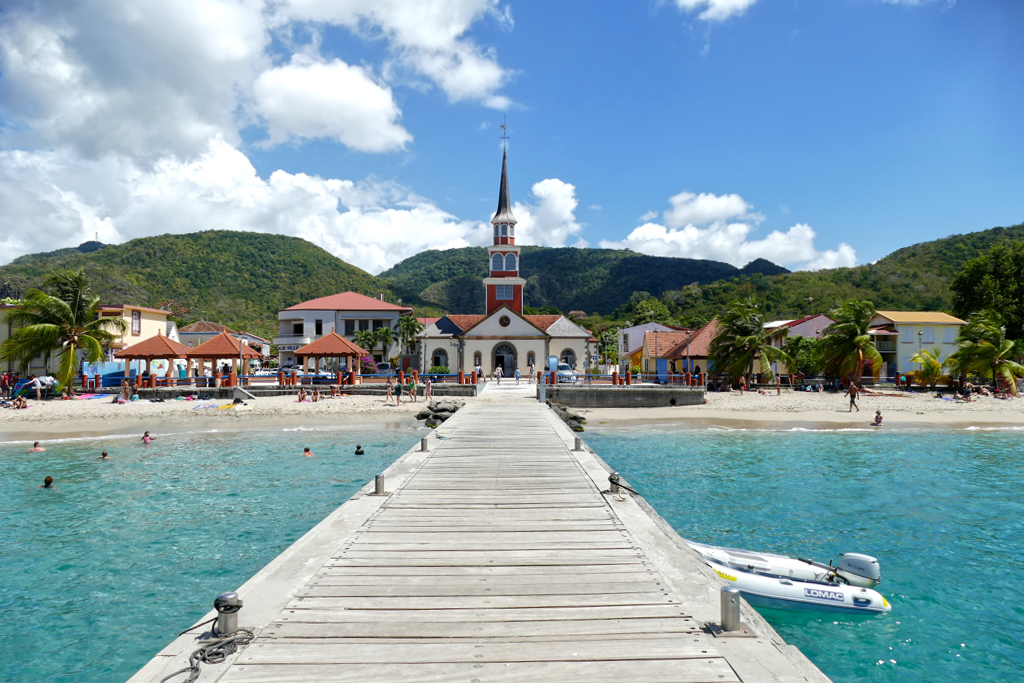
Picturesque wooden houses painted in bright colors line the road that follows the beach and leads through the village to the foot of the mountain. Opposite the Saint Henri church, a long wooden pontoon divides the beach into two parts. In 1762, the British burned the former church of Sainte Antoine down. A new house of worship was then constructed with the generous support of Henri Larcher, a wealthy citizen. As a gesture of gratitude, the new church now honors Saint Henri, patron of the childless, the handicapped, and those rejected by religious order. There you have it.
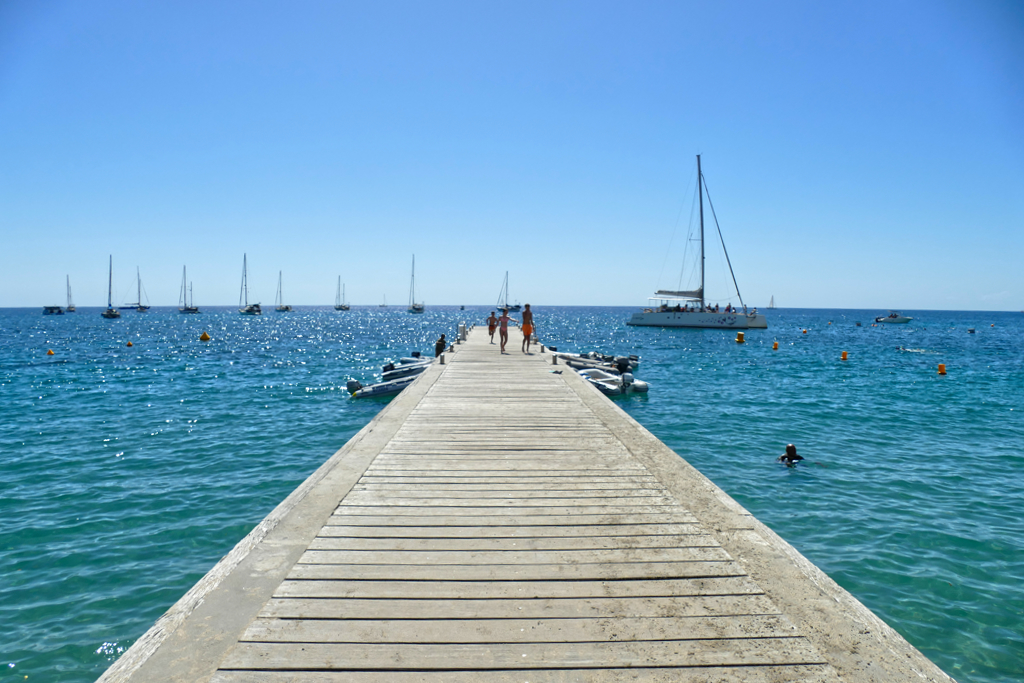
The settlement spreads over various bays such as Grande-Anse and Petite-Anse. The beaches in the south of Martinique have light sand. On the other hand, black lava sand covers the northern beaches. The peculiarity of the two bays Anse-Dufour and Anse-Noire just north of Grande-Anse is that although a small headland just separates them, Dufour is made of white sand, while Anse Noire, according to its name, is covered with black sand of volcanic origin. Actually, it is the only black sand beach in the entire south of the island.
Take It Easy
Although tourism is slowly but surely increasing in Les Anses d’Arlet, the region is still relatively sparsely populated and retains the serenity and charm of a fishing village.
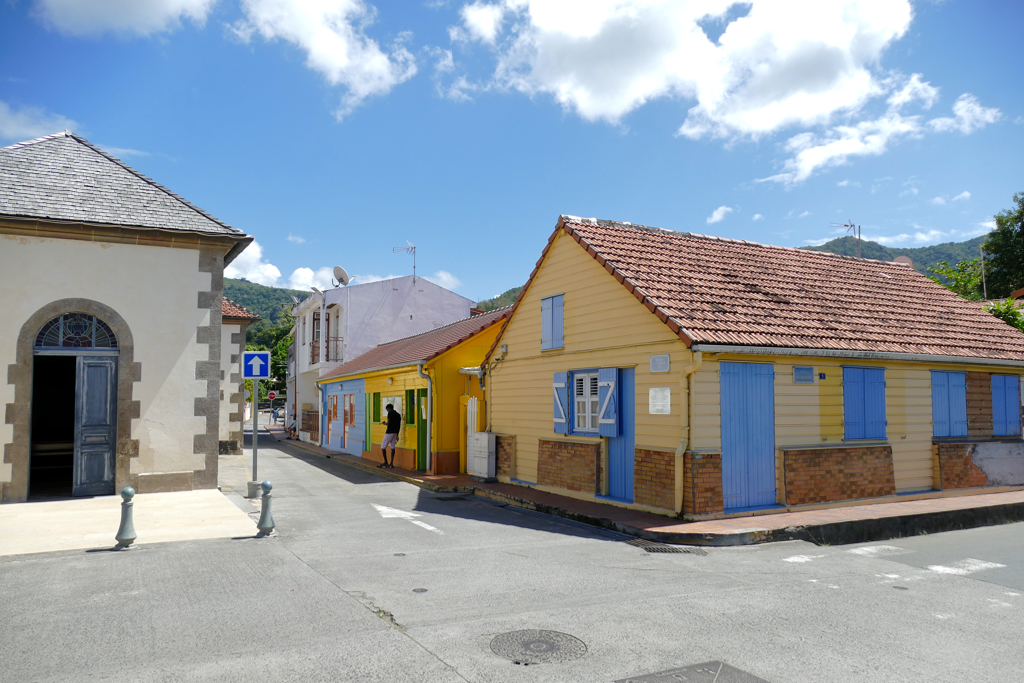
So, are Les Anses d’Arlet truly such a dream destination? Well, there is no doubt that the townlet is cute and the bays in the area are outstandingly beautiful. At the same time, they were the busiest beaches I’ve been to in all of Martinique, especially the Grande-Anse. And I was there on a weekday. I don’t even want to imagine what must be going on there on weekends. So yes, it’s worth visiting Les Anses d’Arlet but lower your expectations when it comes to paradisiacal solitude.
Also another tip: In the southern part of the island around Sainte Luce and Sainte Anne, you can do some wonderful beach hopping just by strolling from bay to bay. Unfortunately, this is not possible at Les Anses d’Arlet. Obviously, you can get to the different beaches, but you cannot walk there. You need to take the bus, and since the buses in this area are particularly unreliable, this would be rather a mission than leisure. Therefore, I recommend you pick one beach – or two at most – and spend the day there. Slow down, this is the Caribbean, after all. Don’t forget that you can always come back to experience a different beach on another day.
Plage du Diamant
If you are into beach walks, the beach Grande Anse du Diamant is the perfect place for you. It’s about three kilometers long and runs between the turquoise waters and an overgrown forest where you can walk on well-designed trails in the shade of leafy trees.
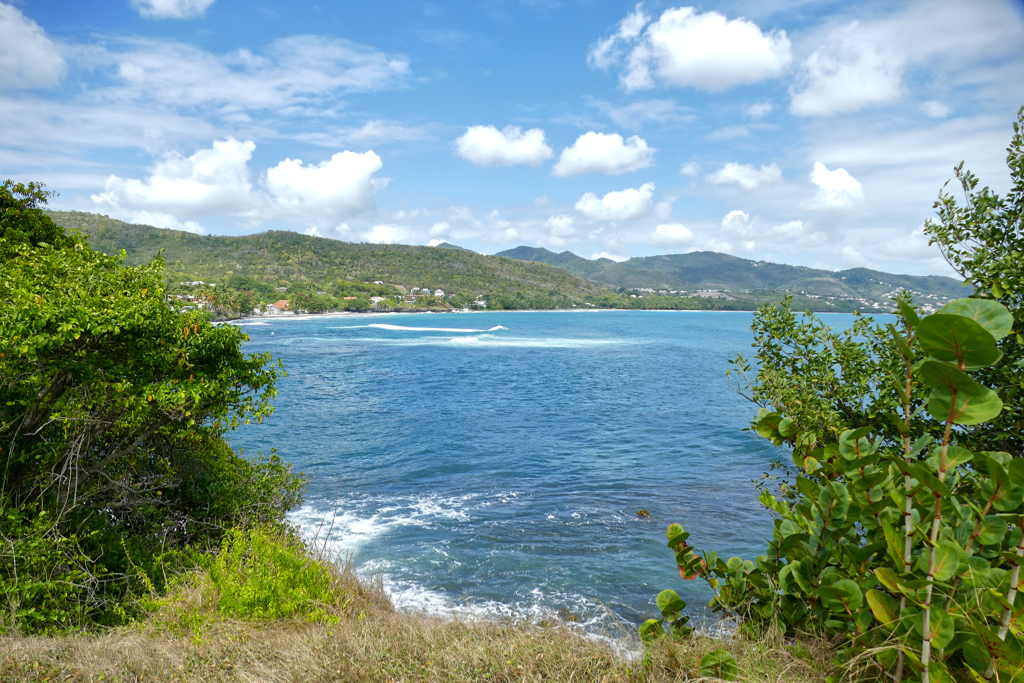
On the western end, the beach merges into the Anse Cafard. This hidden bay might be a good alternative if you are looking for a more secluded place to lay down your beach towel.
From Anse Cafard it’s only a short ten-minute walk to the famous Cap 110 Memorial.
Cap 110 Memorial
In 1830, a ship ran aground on the rocks of Anse Cafard. It was carrying illegal human freight, namely an unknown number of Africans. Obviously, they were foreseen to be sold as slaves. The slaves working at Habitation La Tournell managed to save twenty-six men and sixty women. Yet, the next day, forty-six bodies were found on the coast.
Because it was an illegal passage, the name of the ship and its unfortunate passengers could never be determined. As a result of the tragic event, the town of Le Diamant gained notoriety. Fortunately, this was the last sinking of a slave ship in Martinique’s history.

In 1998, Martinican artist Laurent Valère created a memorial on the site of the catastrophe on the occasion of the 150th anniversary of the abolition of slavery in Martinique.
Valère incorporated many symbolic aspects into his installation: The sculptures are facing towards the Gulf of Guinea, from which their ship probably came. The installation is triangular, reminiscent of the infamous triangle trade. Finally, the white color stands for grief just like in West Africa as well as in the Caribbean.
By the way, Laurent Valère also created an imposing underwater sculpture called Manmandlo in the bay of Saint Pierre.
Maison du Bagnard
Another local sculptor’s work wasn’t so well received, and the poor guy really had a hard time. For some reason, Médard Aribot created the portrait of Confederate States Army officer Georges De Coppens. In 1925, a wild crowd waved this wooden effigy during an election riot. Ten people lost their lives in this turmoil. Eight years after the riots, Médard Aribot was sentenced to life imprisonment – officially, however, for alleged robbery and looting.

Aribot spent his years in prison in Guyana. He was only released when the penitentiary closed in 1945. In 1953, he returned to Martinique. There, in 1960, he built a cute, colorful house just four kilometers west of the town of Le Diamant, where he lived until he died in 1973.
This so-called Maison du Bagnard, hence, the convict’s house, becomes a curious tourist attraction after the artist’s death. In this way, Médart Aribot and his sad fate will not be forgotten.
The small house is free-standing and can generally be visited around the clock. However, it is currently – in spring 2024 – surrounded by small scaffolding and is not allowed to be entered for security reasons. A visit is still very worthwhile.
Plage de Sainte Luce
As I mentioned above, there are some stretches of coast in Martinique where long beaches and smaller bays line up seamlessly. As if that wasn’t wonderful enough, cozy paths are running along these beaches through the adjacent forests and bushes.
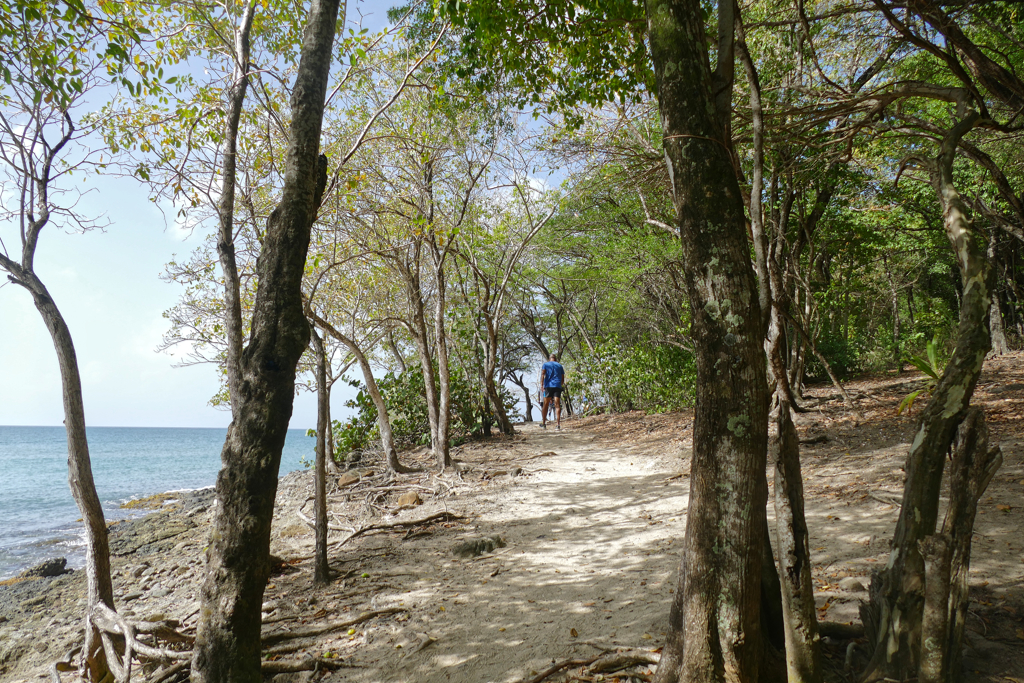
This way, you can walk for hours in the shade of the trees. Or you just stroll comfortably from beach to beach and try out which one suits you best.
You know the old saying: Home is where you lay your hat beach towel.
One of the finest one of those beach trails connects the towns of Sainte Luce and Les Trois Rivières.
Plage Gros Raisin
West of Sainte Luce starts a row of seven beaches stretching over five kilometers. It begins with the Plage Gros Raisin. To be honest, it’s the least alluring part as it is a very small and narrow strip of sand just below the road. However, if you just need a quick dip in the cooling waters, it’s totally fine. What I particularly liked about this beach was the small meadow on the other side of the walking trail. As you spread your beach blanket there, for once, you don’t have fine sand getting in all of your stuff.
Anse Gros Raisin
However, when I arrived in Sainte Luce, I thought the Plage was actually the entire beach. Understandably, I was quite disappointed. But just a very short walk apart is the Anse Gros Raisin, and that’s a whole different story.
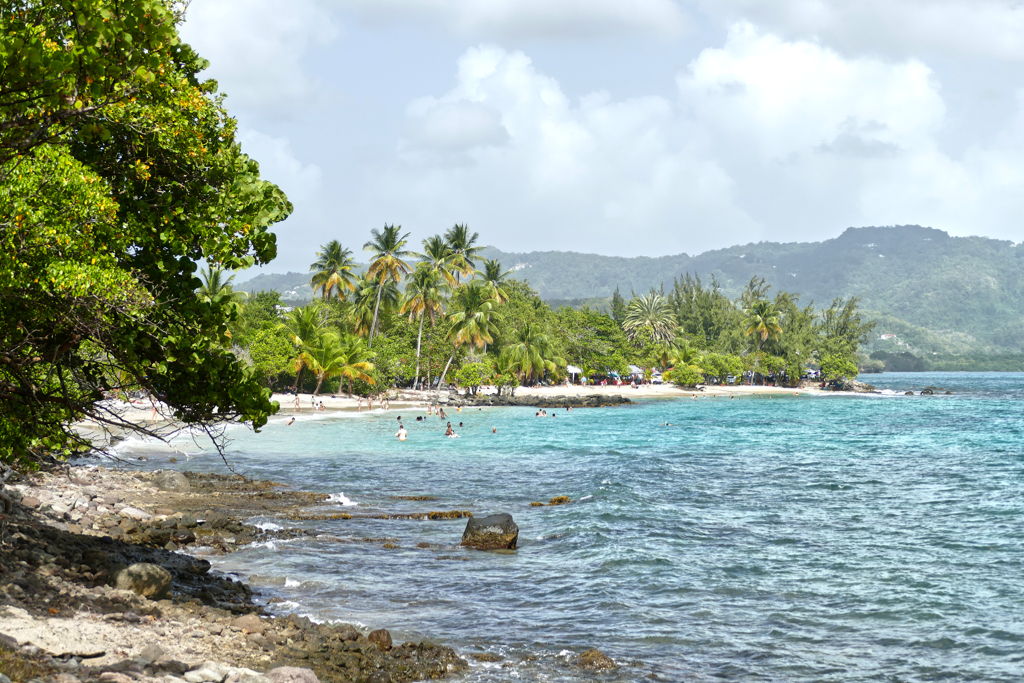
This beach is long and broad. It has two beach restaurants and is just perfect for sunbathing, swimming, and even snorkeling right off the shore.
Plage de Pont Café
Continuing the path, you’ll get to Plage de Pont Café. It consists of two parts: The first is a small cove that has a secluded and private vibe to it. The other part, however, is all the more humming. It is a fairly long beach, divided into small nooks by the shady vegetation.
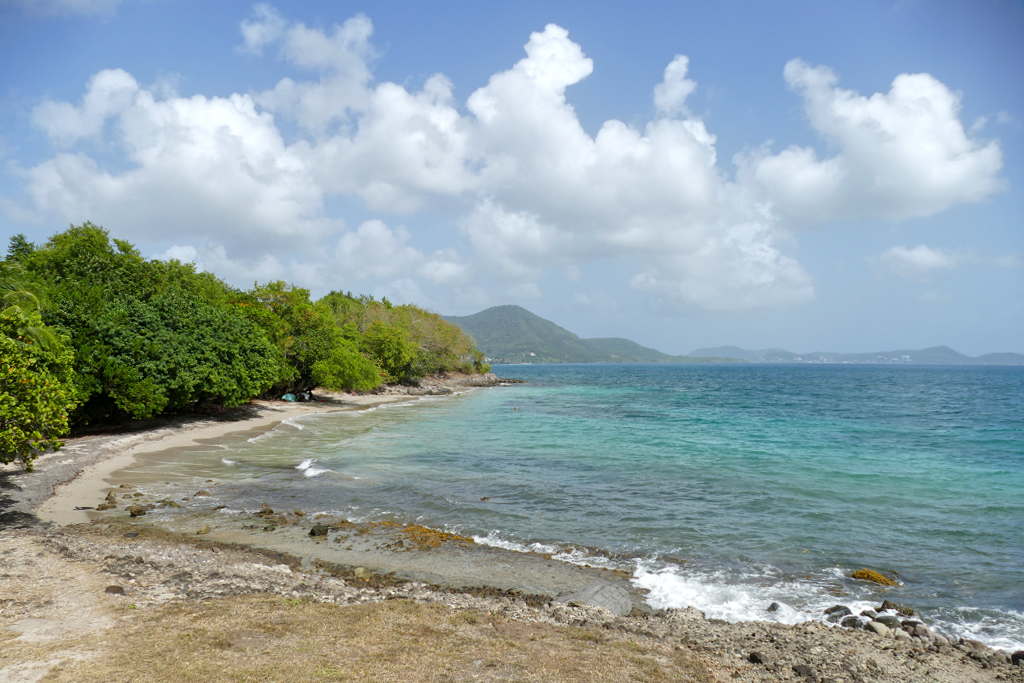
However, since the beach is right in front of the resort Pierre & Vacances, it is quite busy and they also offer unnerving activities like jet skiing. For this reason, Plage de Pont Café was just a thoroughfare for me.
Fond Banana
The next is the so-called Fond Banana. It is a long yet rather narrow beach. It is very quiet and shaded. Actually, the vegetation here is so dense that it’s easier to find a spot in the shade than in the sun. However, because of the highly poisonous manchineel tree alone, I have some concerns when it comes to tropical vegetation and make sure not to touch any plants.
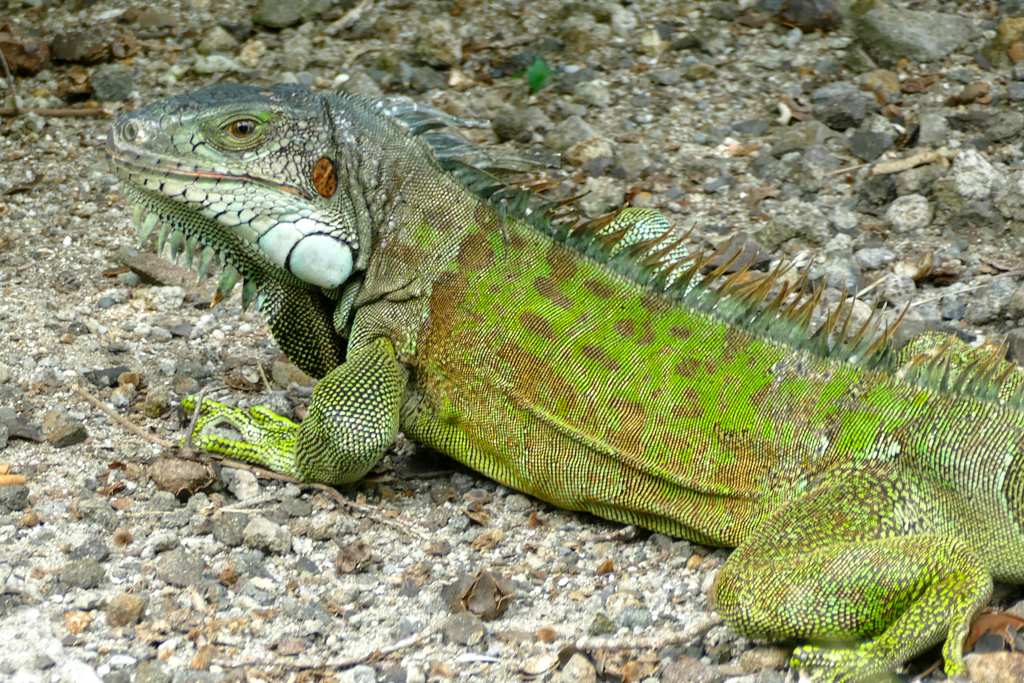
Therefore, although I love my spot in the shade, I prefer places that are not enclosed by bushes and trees. I know a lot of people like these little nooks the vegetation forms on Martinique’s beaches. They grant seclusion and privacy.
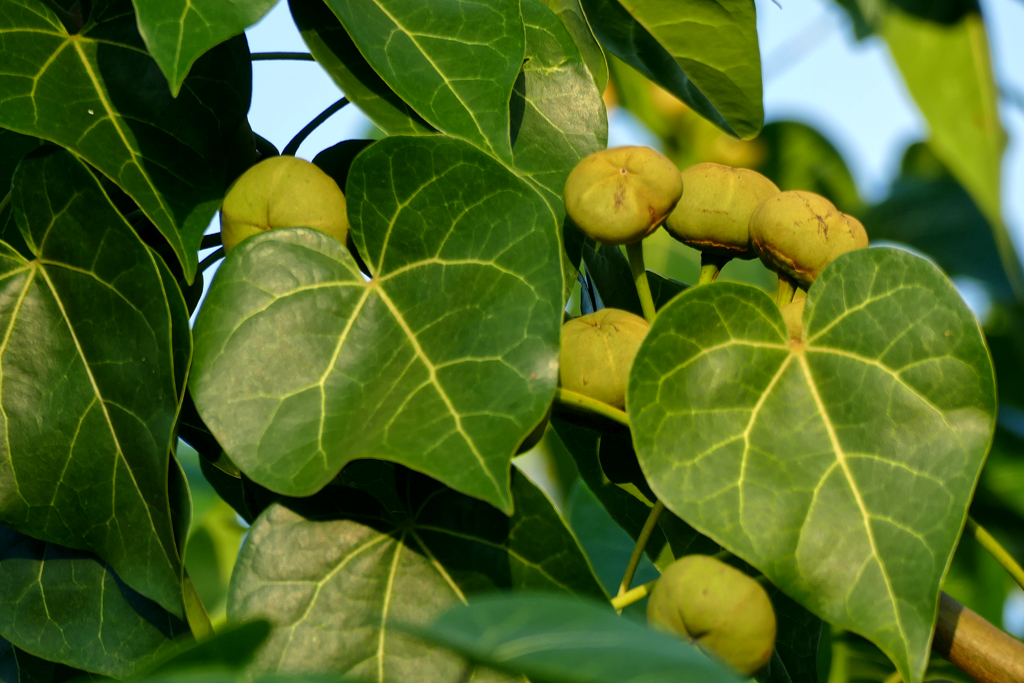
Do not eat, touch, or even profoundly inhale the air around manchineel trees!
Obviously, I’m also not a fan of crowded beaches. However, I don’t feel very comfortable in these alcoves.
But hey, isn’t it great that the shore of Sainte Luce offers something for every taste?
Anse Corps de Garde
As we are talking, next comes my personal land beach of Cockaigne. Anse Corps de Garde is a fairly long and broad beach in a superb cove.

It is a bit livelier than for instance Fond Banane but still far from being overcrowded. I was there on a Sunday, and although there were large families with many kids frolicking in the water and groups of jolly hikers assembled for a break, it was far from noisy or crazy.
Anse Désert
Anse Désert is very similar to Anse Corps de Garde: long and wide with many beautiful spots in the shade of sea-grape trees and coconut palms. The sand here seems actually more powdery and golden, and the ambiance is even a little more dreamy.

The only drawback: There are a lot of rocks in the water and there could also be sea urchins there. I therefore strongly recommend wearing water shoes with stable soles.
Other than that: Welcome to paradise!
Anse Mabouya
Since Anse Mabouya is the farthest beach from the town of Sainte Luce, it is rather secluded and quiet. If you don’t make it to the last stop on your beach hopping on foot but get there by car or public bus, you’ll find the entrance at the end of a dead end where boats are launched on the southern tip of Quartier Désert.
Here you can laze in the sun in the shade of mangroves and frangipani and enjoy a marvelous view of the rock Le Diamant and the Morne Larcher.
Plage de Sainte Anne
As you make your way from Le Marin to Sainte Anne, you’ll pass the entrance to the Plage Municipale, the city beach.

Facing west, the beach stretches over five kilometers. It consists of fine sand lining clear turquoise waters and offers amazing views of the entire coast all the way to Le Diamant.

Trees and palm trees provide shade. In between you can fortify yourself in one of the many small makeshift snack bars and eateries, although I personally find them a bit overpriced. So bring your own picnic.
It’s Public
In the 1960s, the Club Méditerranée hotel chain opened one of its complexes in the Pointe Marin beach area. Like the Caravelle Beach in Guadeloupe, this part of the shore is primarily used by hotel guests, but it is public and can be accessed by anyone. Of course, this only applies to the beach itself, not to the facilities. So if you spread your towel right next to a hotel lounger, that’s weird but not prohibited. On the other hand, you are not allowed to use the shower next to it or hop on one of their surfboards, obviously.

Now, the Club Méd portion of the Pointe Marin beach is so small that you can easily do without it. I just wanted to point out that this is a publicly accessible beach as you have to cross it to get to the top. From there, you have another fantastic view, this time on the marina of Le Marin and the mountains behind. Hence, don’t miss out on a walk along the entire beach.
Plage des Salines
I must say I really got into this beach hopping on foot and I’d argue the coastline south of Sainte Anne offers the most alluring bays. You are hiking from cove to cove on a comfortable trail in the shade of a thousand beautiful trees before you finally reach the Anse des Salines, the grand finale.
Plage Anse Tonnoir
However, I set off for an amazing beach hopping. Although I must say that already the first beach that is still within the city limits of Sainte Anne was very tempting.
It is just a small stretch of sand south of the town’s picturesque fishing harbor from where you have a great view of the entire west coast.
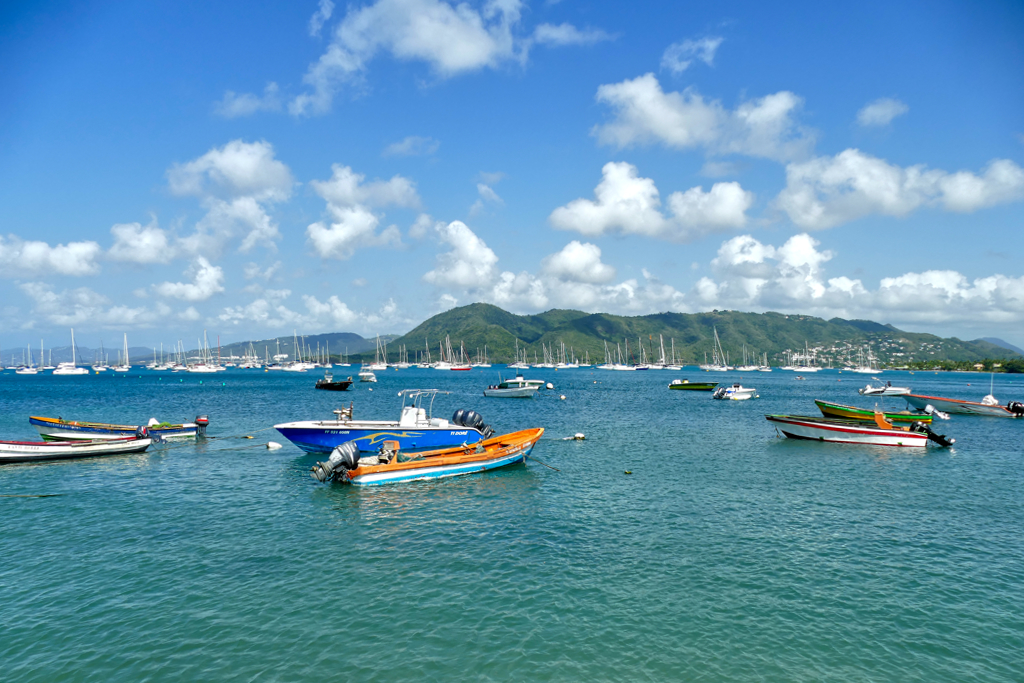
It’s a bit unfair: In any other place in the world, you would love Plage Anse Tonnoir! The sand is white, the water is clear, and there are plenty of trees so you can relax in the shade.
On an island like Martinique, which is lined with beaches that are otherwise only known from ads, a beach drops in the ranking due to even the slightest imperfection. As a matter of fact, Plage Anse Tonnoir’s only imperfection is that the beach borders directly on the city and I also wanted to see the other dream bays. No, there was no way I could finish an hour-long hike after five minutes on the city beach. Other than that: This beach is absolutely fine if you have no ambition and just want to laze around in the sun.
Plage de Anse Caritan
Hence, instead of spreading my beach towel right on Plage Anse Tonnoir, I made my way up the road and turned left following the sign Plages.
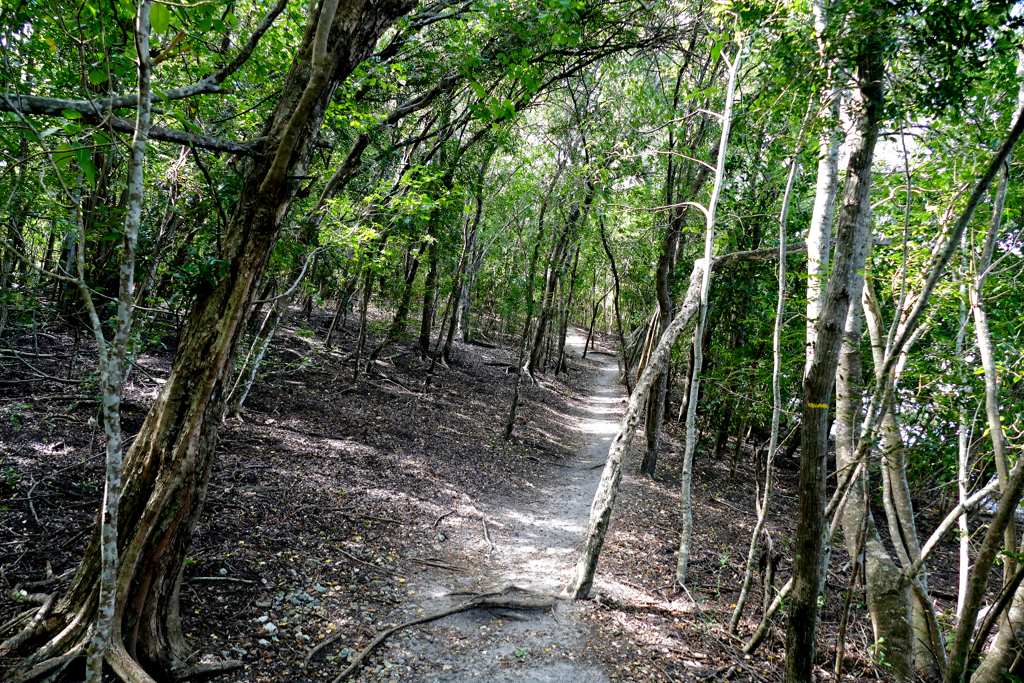
After less than one kilometer, I got to Anse Caritan which marks the start of the so-called Trace des Caps hiking trail. It is a rather narrow white sand beach. At high tide, it is sometimes completely covered with water as the strip of sand is so thin. Just like at Fond Banana in the Sainte Luce area, you have to make yourself comfortable in little nooks amidst the dense vegetation.
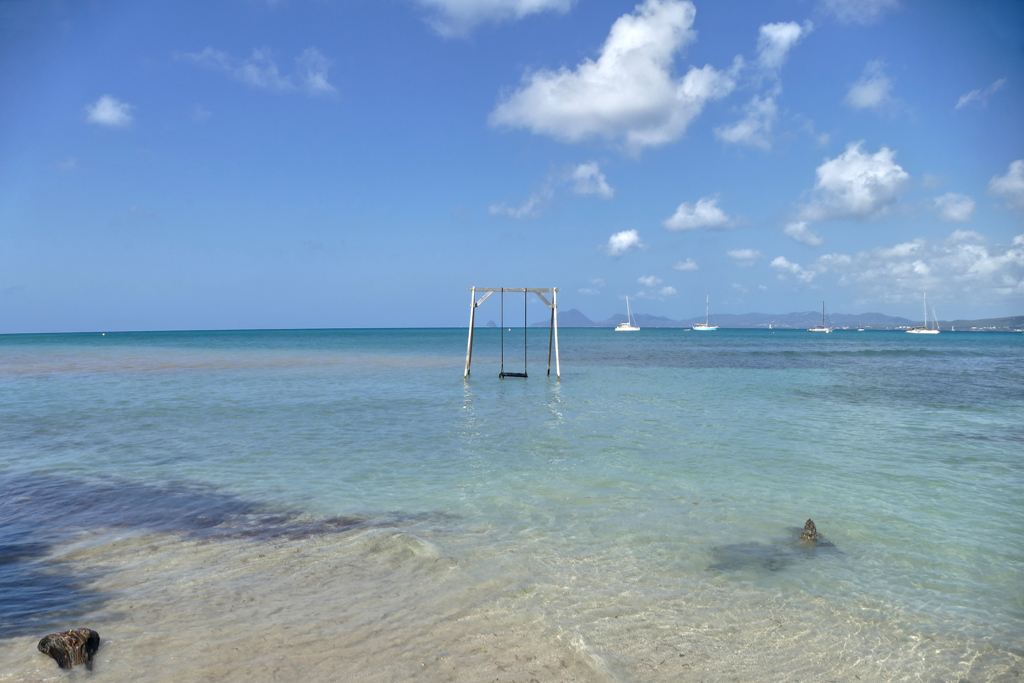
However, as Anse Caritan is next to a spacious hotel complex, there are always quite a few visitors. As the shore is well-protected from waves by the protruding Sainte Anne peninsula, it is also appreciated by families with young children. Especially as they can enjoy all kinds of slides and trampolines at the small water park Maya Beach Club. Nevertheless, with a fee of 10 €uros for an hour, it’s not exactly cheap.
To enjoy some fun in the sun for free, make your way to the Balançoire, an off-shore swing located more or less exactly where Anse Caritan merges into Anse Meunier.
Anse Meunier
Anse Meunier’s coves are a bit more spacious than those of Anse Caritan. It’s a truly magnificent beach with clear and rather shallow water perfect for a swim during your hike.
Here too, shrubs have formed nooks’n’crannies, however, they have a less cramped feel to them.
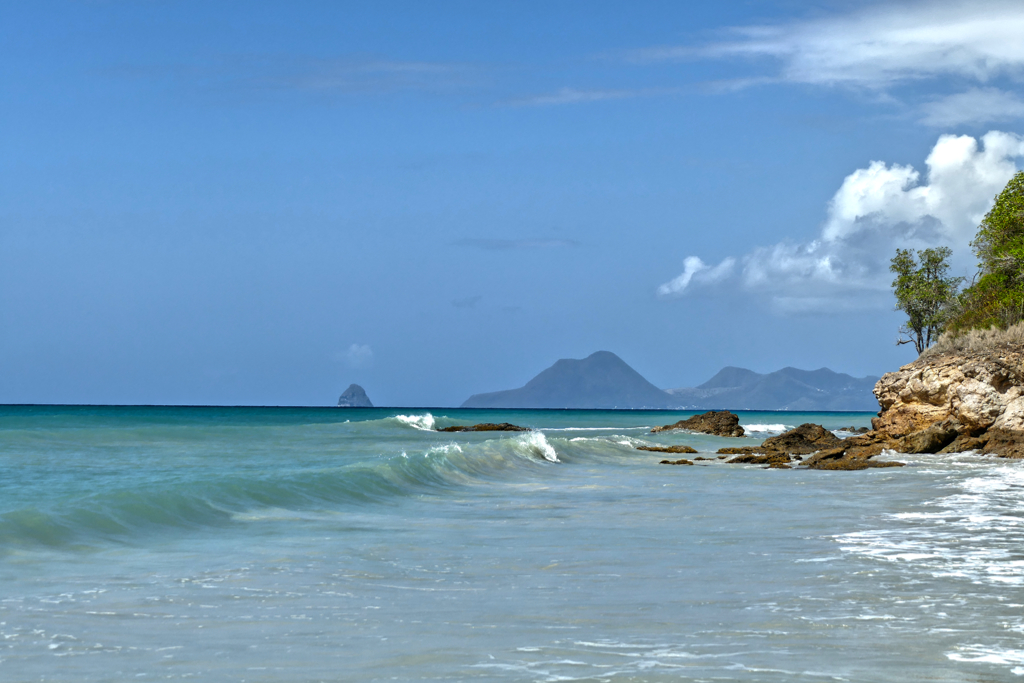
After a refreshing dip and a thousand pictures of the open sea with the rock and the coastline of Le Diamant in the backdrop, let’s continue our walk.
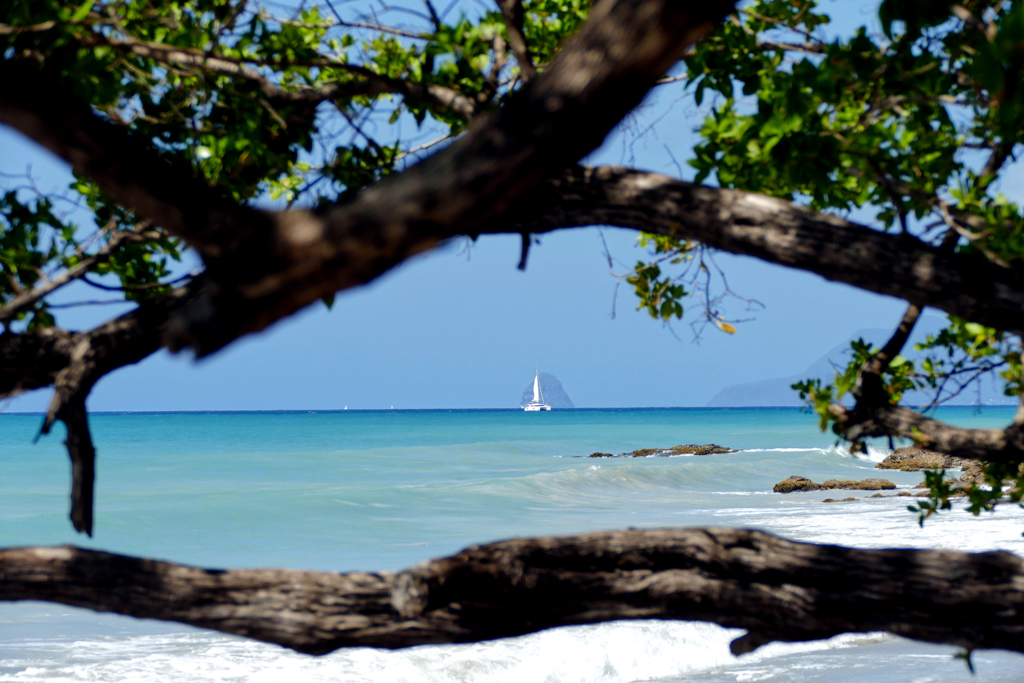
The closer you get to the so-called Pointe Catherine, the broader the beach gets. Slowly, you get an idea of what to expect at Anse des Salines.
Pointe Catherine is a headland separating Anse Meunier from Anse des Salines. As it protrudes into the sea at a height of about twelve meters, you absolutely need to make a small detour to enjoy the marvelous views from there.
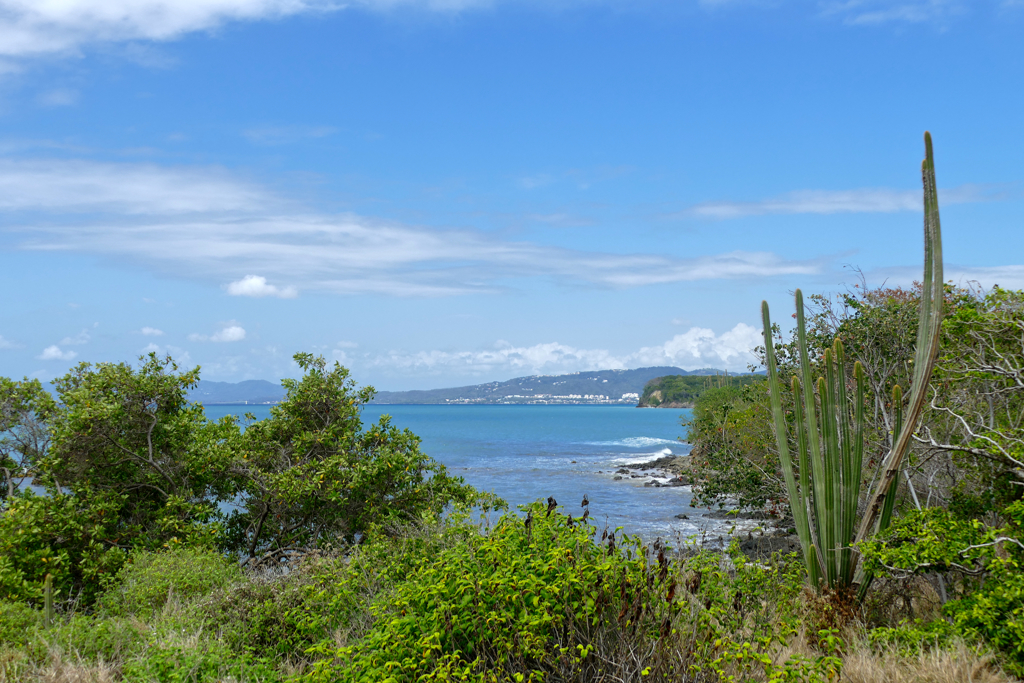
What’s also interesting is that this is the only area where you get to see cacti.
Anse des Salines
Then, as you walk back down from Pointe Catherine, you already spot the first part of the legendary Salines beach, presumably one of the most beautiful beaches in the entire Caribbean. Nature divided it in three parts. The first one is the Petite Anse. It is much less frequented than its big sister behind the next promontory. However, it is preferred by naturists, hence, if you are into textile-free swimming and sunbathing, this might be the perfect spot for you.
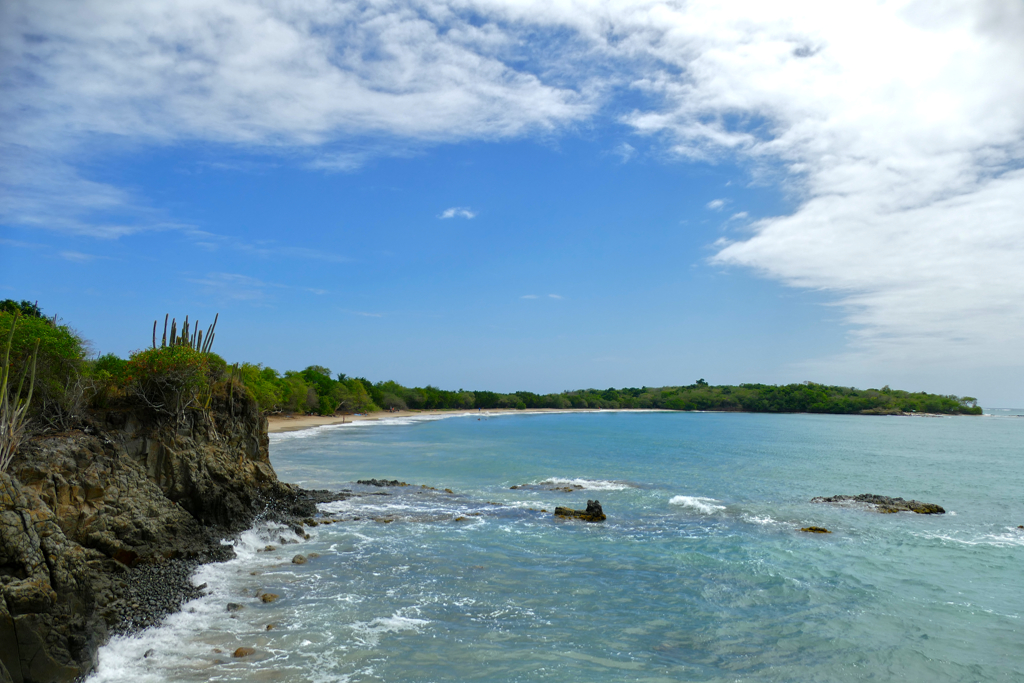
Nearly two kilometers long, Grande Anse des Salines is undoubtedly the most famous beach in Martinique. It is truly magnificent with its fine white sand protected from the scorching heat by seagrape trees and palm trees. By the way, the white sand of the Caribbean is in fact only eroded calcite from shells and corals.
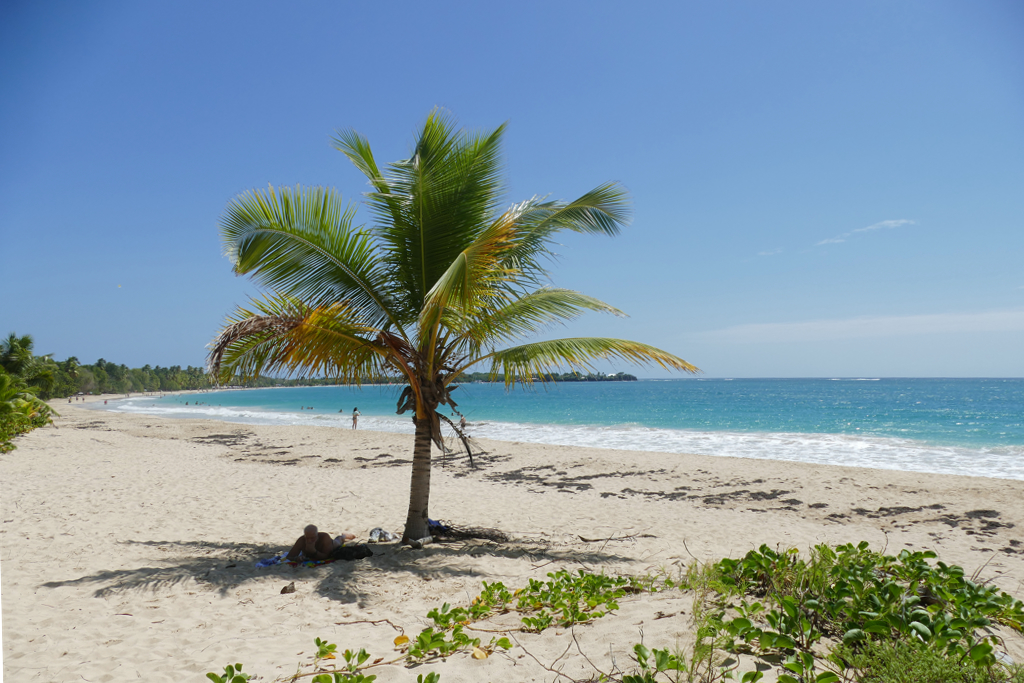
It will come as no surprise that a magnificent place like this attracts lots of admirers. Therefore, it is busy all year round. You’ll find a bit more privacy on Petit Anse as well as the Grand Terre beach which is the last segment of Grande Anse des Salines.
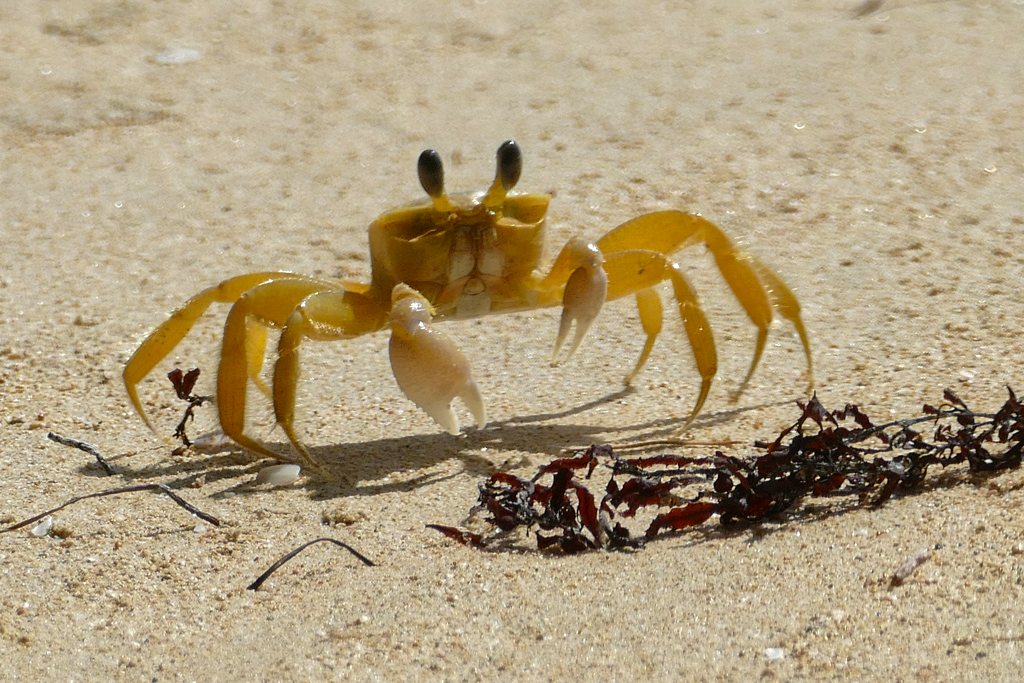
Grande Anse des Salines owes its name to the brackish water lagoon located just behind the beach. Surrounded by mangroves, it is perfect for bird-watching. This is also the starting point of the very popular hike across the Savane des Pétrifications.
What To Pack For a Beach Day
If you stay at a beach hotel, you can simply walk from your room to your sun bed in a swimsuit, a book, and a cocktail in hand. In that case, kudos – and you won’t need this checklist. If however, you intend to visit more or less secluded beaches by public bus, you might wanna put a bit more thought into what to pack for the day.
Keep in mind that you’ll leave your accommodation in the morning, taking the bus to some remote place from where you then return only in the late afternoon. If you forget to take certain things with you, you won’t have them available during the entire day, it’s as simple as that.
Therefore, the below list contains not only quintessential items like your wallet and your reading glasses but also some gadgets that are not crucial but will make your day on the beach more comfortable and pleasant.
1. Wallet and Keys
Sometimes it’s the most evident stuff that we tend to forget. While you are focusing on your swim goggles, you realize that you left your wallet in the room only the moment you need it. Therefore, the most important item is your wallet with some cash, one credit card for emergencies, and some form of ID. I’m emphasizing taking only one credit card for security reasons. If you should lose your wallet or if it gets stolen, you’ll still have your other cards safely in your room. Also, I’m always taking my ID with me instead of my passport. Yes, losing it is annoying, however, it is not as serious as losing a passport.
Oh, and don’t forget to take your keys before you slam that door. I’m always having a noticeable lanyard with me that I attach to my holiday apartment key during my entire stay. Maybe this idea works for you, too.
2. Sun Protection
When in a tropical country, I smother myself in sun protection before I even leave the house. In Martinique, I used SPF50 on my face, my neck, and my shoulders and what can I say – I still got slightly burned. The intensity of the sun definitely changed over the past years. Although I got a bit less sensitive over the following days, I still avoided wearing tank tops or strappy dresses as I had the impression that I didn’t burn on the beach but while walking. Therefore, I opted for shirts with short sleeves and high-necked T-shirts for best protection.
This being said, I recommend you have always at least a small bottle of sunscreen with high SPF on you. Also, don’t just carry it around, but use it.
3. Hammock or a Beach Towel and Possibly an Extra Towel
Obviously, you won’t be lying in the sand, hence, you need a beach towel. However, I like to have also a smaller towel with me just in case. Apart from serving its original purpose, it can also be folded or rolled into a small pillow.
During my trip to Guadeloupe and Martinique, I noticed for the first time many people taking a hammock with them to the beach. And on these islands, it makes total sense as there are so many trees on basically every beach where you can easily attach your mobile bed. However, I had to schlepp so many things, that an additional hammock would have been simply too much for me.
4. Swim Suit and a Spare
When I’m planning on spending the day on the beach, I put on my swimsuit underneath my clothes. If you do that, too, don’t forget to pack either some underwear or simply a second bikini so you can change and don’t have to spend the day in wet swimming clothes after a refreshing dip.
5. Sun Shades and Possibly Reading Glasses
In the bright sunlight on a white beach, sunshades are not a fashionable accessory but an indispensable necessity.
If you need reading glasses, you probably have also sunshades with the visual acuity you need. If not, don’t forget your regular glasses since you don’t want to schlepp that big novel in vain.
6. Sun Hat or Shawl
Just like you don’t need shades just to be trendy, a sun hat is not only a fashion statement. Especially if you’re planning on walking down a beach for a while, not covering your head can become truly dangerous. Choose one with a quite wide rim to really protect your face.
To cover also your neck, a light scarf or shawl that you wrap around your head and neck can be a very chic alternative. Either way, make sure to cover your head when you are exposed to the sun.
In Martinique, most beaches have quite dense vegetation so you’ll always find shelter from the sun. Actually, I was mostly exposed to the sun as I was walking around.
7. Swim Gear, Goggles, or Snorkeling Mask
So now we finally leave the necessity department and we’re moving to the fun section. Goggles or even a mask will allow you to experience the underwater world in Martinique’s crystal-clear bays.
8. Swim Shoes
I’d say that you only need swim shoes if you have extremely sensitive feet and even then, only in very few spots. I brought mine with me on this trip and used them once. Also, I think I just used them for the sake of it.
9. Change of Clothes
I already reminded you to take a change of underwear or a spare swimsuit with you. In addition, I like to pack a spare T-shirt and even light trunks just in case I get wet or spill something on myself. Remember, you are planning for a long and hopefully a bit adventurous day, hence, expect the unexpected.
10. Book
Forgetting your book won’t ruin your day trip. However, it’s annoying to find yourself on a beach where you could comfortably enjoy a good read only to realize that you’ve left it behind.
11. Mobile Phone with Head Phones
Your mobile phone is definitely something you should have on you at all times. You can quickly snap some pictures of great scenery, listen to your favorite playlist, check the bus schedules – and call for help. Although I hope the latter will never be necessary, I know from my own experience that your phone should be ready to save you at any time.
Now, the headphones. I know that there are people who hold extensive conversations on speakerphone in public places. Or who watch movies or listen to music as if the world was theirs alone. I hate that. So if you are not all by yourself in a secluded spot, please, use headphones.
12. Storage For Valuables
A gadget that helps to protect your valuables is probably far more important for solo travellers like me. But also couples or even groups of friends might want to frolic carelessly in cool waters without getting robbed.
Various kinds of pouches store your money, credit card, ID, phone, and the like. As those containers are waterproof, you can have all your valuables on you even in the water. I’m personally not a big fan since I simply don’t feel comfortable carrying all that stuff with me while swimming or snorkeling. Also, one of my most valuable items is a camera that doesn’t fit in any of those containers.
Therefore, I’m using a mobile safe. That’s a bag reinforced with a metal web that cannot be cut open. Also, it is secured with an iron string and a padlock. Then, you need a post or a big tree branch to attach the safe firmly. Especially on Martinique’s overgrown beaches, finding the perfect trunk or branch is no problem at all.

13. Snacks
Although many beaches in Martinique have some food trucks or a restaurant nearby where you can get a snack, I like to bring mine. One good thing about the French influence in Martinique is the countless bakeries that you find in every town and even the smallest village. Baguette, croissants, pain au chocolat, chausson aux pomme that literally melt in your mouth. Yes, as delicious as in France. There are also quiches, puff pastries filled with minced meat, and juicy sandwiches. In any case, your snack for the beach day is ready and waiting for you at your local boulangerie! In addition, I like to take some hard fruits or vegetables like apples, cucumbers, and carrots with me to the beach. These snacks are simply more refreshing.
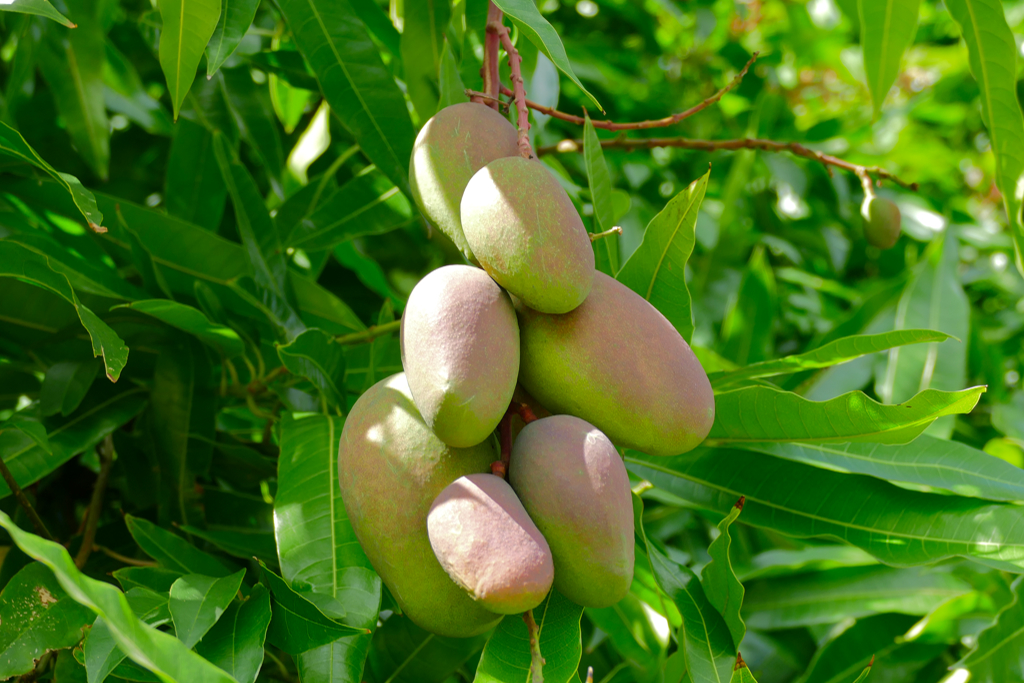
14. Water And Possibly some Juice or Soda
While having something to munch on is good but not necessarily vital, having enough liquids to replenish definitely is. For a beach day, that should be at least a bottle of 1.5 liters.
But what good does it do to have something with you that you don’t like to drink? After a while, I tend to get tired of drinking plain water. Therefore, I also take a small bottle of juice or even a soda like Orangina or Sprite with me- just to mix things up a bit and ensure that I drink enough over the day.
What Do You Have to Add?
I would love to know you but obviously, I don’t.
Therefore, I might have missed listing something that you urgently need to enjoy a careless day on the beach.
What is it?
I’d be pleased if you shared it with me and the other readers in the comment section below!
How to Get to the Beaches by Public Bus
Martinique’s bus network is divided into south, central, and north, a journey between towns costs around 2 euros, journeys with regional buses cost 1.50 euros. You can purchase a season ticket or buy tickets using the App MT Ticket. It was too much effort for me for almost two weeks on the island, so I bought my ticket from the driver every time.

Yes, there are plenty of buses that go to the most remote corners of the island. However, you often have to change buses at least once; for longer distances, this can sometimes take three or four legs.
But Renata, that’s not so bad.
Better Late Than Never Early
Well, hold that thought. I’m afraid you’ll change your optimistic attitude when I tell you that the waiting time for the next bus is often half an hour, but sometimes also 45 minutes. And that’s according to the schedule. In addition, your first bus may have been particularly fast so that you arrive at the connecting stop ten minutes before the scheduled time, but the next one is fifteen minutes late. Now calculate the waiting span in real time and the whole thing doesn’t sound so great anymore.
Obviously, these are extremes. If this kind of connection was always the case, I certainly wouldn’t be promoting enthusiastically taking the bus. However, a very long wait can occur. One consolation: the most important junctions where I had to wait for long were always at a roundabout where there was at least one major supermarket. So I simply used the waiting time to do my shopping – either refreshments for the beach or groceries for my apartment. That was very practical, I just had to keep an eye on the time and remember that the next bus could come ten minutes earlier than scheduled, so I had to make it back to the stop in time.
Prepare
With very few exceptions, I think it is essential to check your connection options for the day and, if possible, write them down so that you don’t get confused. You can easily check routes on Google Maps. Simply enter the start and destination and the desired departure or arrival time. Then click on the little bus symbol and you will see all the options. Things get a little better with the App Martinique Mobilité. It works the same as Google Maps, but you can easily save the connections and don’t have to write them down or remember them.
Ten Crucial Tips For Exploring Martinique By Public Bus
- The most important tip to make your bus ride at least tolerable: Do consider the passage a valid part of the whole experience.
If you consider your bus ride a wasted period of time between two meaningful activities, you’ll get mad. Think of it as an original tour in an authentic vehicle: Look out the window and enjoy the amazing scenery, the turquoise waters, the endless sugarcane fields, the swaying palm trees. Try to get a glimpse of the towns and villages.
This is neither New York nor Paris nor Tokyo, this is a Caribbean island, and the bus ride is part of the whole experience. So do yourself a favor, reset your watch, lean back, and go where and when the bus takes you.
————————————— - Don’t plan too much for one day. One or two destinations will be enough. Yes, in cities like London or Berlin, you can design a meticulous program for the day and follow through. Taking a day trip on public buses in Martinique is much more complicated and tiring: you’ll be walking quite a bit, you’ll have to carry all sorts of stuff with you, you’ll have to plan for longer waiting times, and all this in the tropical heat. Believe me, I’m a trooper when it comes to itineraries. That’s why I planned five spots on my first day. I would have even completed the program. But in the afternoon, I was completely exhausted, so I postponed the last stop to another day. From then on, I limited my itineraries to two spots. This way, I was often back around 3 p.m. and had still two or three hours left to relax on the beach with a nice book.
————————————— - However, plan your trip as thoroughly as possible in advance by using Google Maps or the App Martinique Mobilité. Yet, since the buses are not a hundred percent reliable, stay flexible, don’t freak out, and consider an alternative connection as you go.
————————————— - Be at the stop at least ten, better 15 minutes before the scheduled time.
————————————— - While waiting, don’t get distracted by reading or chatting with others. Keep your eyes on the road if the bus is coming. Because if you just hang around at the bus stop, the driver won’t consider you a potential passenger and might just merrily pass you by. As soon as you see the bus approaching, give the driver a sign by lifting your arm or waving.
————————————— - Keep in mind that the vehicle might look different than you expect it. Instead of a large coach, it can be just a middle-sized white van with the number on a piece of paper in its windshield. This info is relevant as you have to flag the bus down. It happened to me that for some reason, I expected a certain bus to be big and colorful. Only as a white van raced past me did I realize that I just missed my bus.
Therefore, it’s better to wave frantically to a potential vehicle once too much than let it pass you by.
————————————— - Make sure to have small change to pay your fare as the drivers accept only bills up to 10 €uros.
————————————— - Try to take the bus at the final stops respectively as early as possible: If you have the choice between two stops, wait at the one the bus serves first. Mind you, once all the seats are taken, the bus is full and the driver will leave you standing at the bus stop. Especially in areas where there are only a couple of those smaller vans a few times a day as well as during rush hour in the afternoon, it is the survival of the fittest.
————————————— - Never rely on the last possible connection or the latest scheduled coach. Plan your trip in a way that you can take at least one later bus.
————————————— - Even if you are totally opposed to hitchhiking, consider hitching a ride your last resort. Never have I ever hitchhiked before, yet, Martinique’s bus drivers made me leave that comfort zone right on my very first day on the island.
Well-Organized Activities
As I pointed out, most of Martinique’s wonderful places can be reached by public bus. However, this will cost you some time and possibly a lot of nerves. Hence, an organized tour might be a more suitable option, especially if you don’t have much time on the island. Also, if you want to engage in activities on the water like sailing or snorkeling from a boat, you have to go on a tour unless you bring your own yacht.
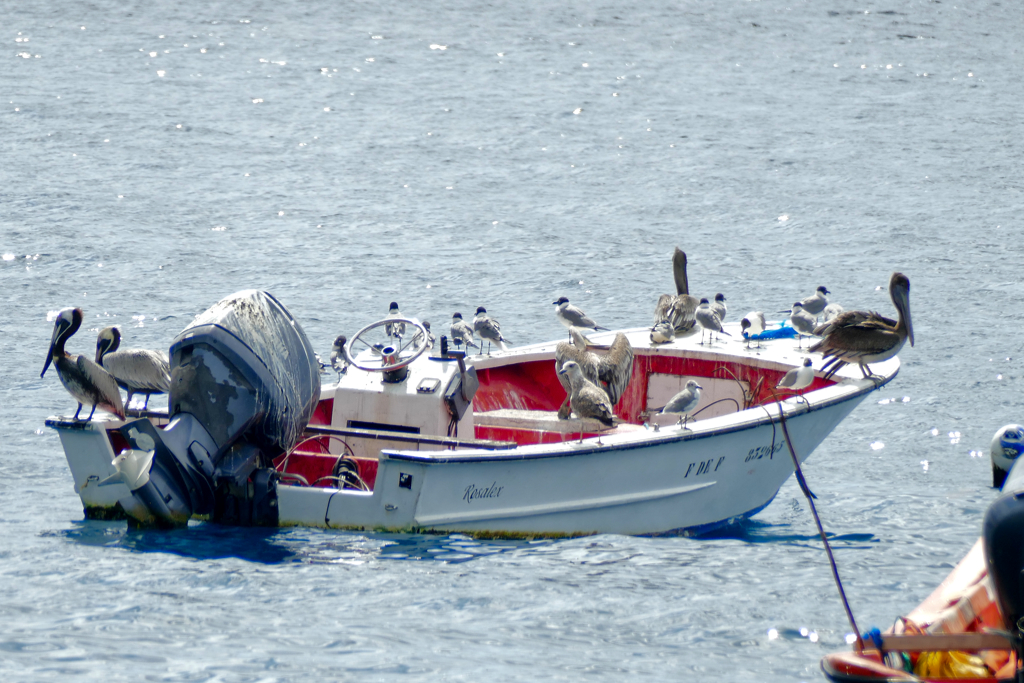
Therefore, here are some great tours to choose from*:
Although Martinique’s beaches are just fantastic, they are not the only attraction the island has to offer. In my encyclopedic guide Magnificent Martinique: Ten Places Not to Miss on Your Visit, I’m introducing…well, yes, ten places not to miss on your visit.
Map
This map should help you to find the most beautiful beaches in Martinique that I’m introducing in this post. Clicking on the slider symbol at the top left or the full-screen icon at the top right will display the whole map including the legend.
Pinnable Pictures
If you choose to pin this post for later, please use one of these pictures:
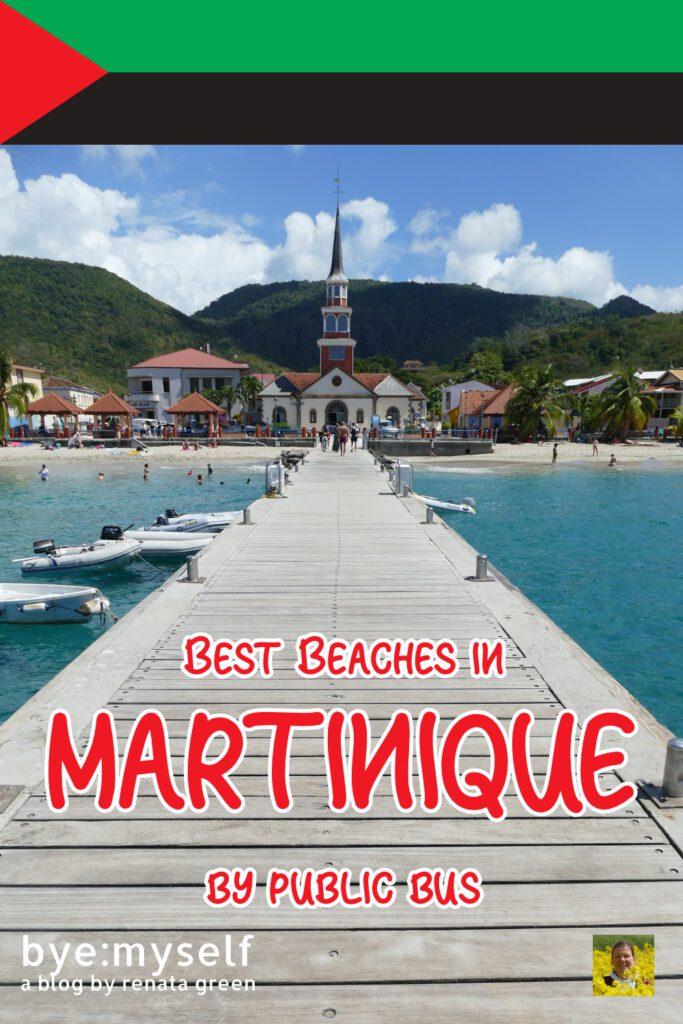





Did You Enjoy This Post? Then You Might Like Also These:
The Best Beaches in Curacao You Can Easily Visit by Public Bus
One Week in BONAIRE: The Best Activities Beyond Diving
GRAND GUADELOUPE: Complete Guide And Perfect Itineraries (also for travels by public bus)
Murals in CURACAO: The Best Street Art Projects in Willemstad
Guide to VINALES – Cuba ‘s Rural Paradise
Guide to BARACOA – Cuba’s Hidden Gem
BONAIRE Totally Unexpected: Street Food And Urban Art Tour
SANTIAGO – Capital of Afro-Cuban Culture
* This is an affiliate link. Hence, If you book through this page, not only do you get the best deal. I also get a small commission that helps me run this blog. Thank you so much for supporting me!
